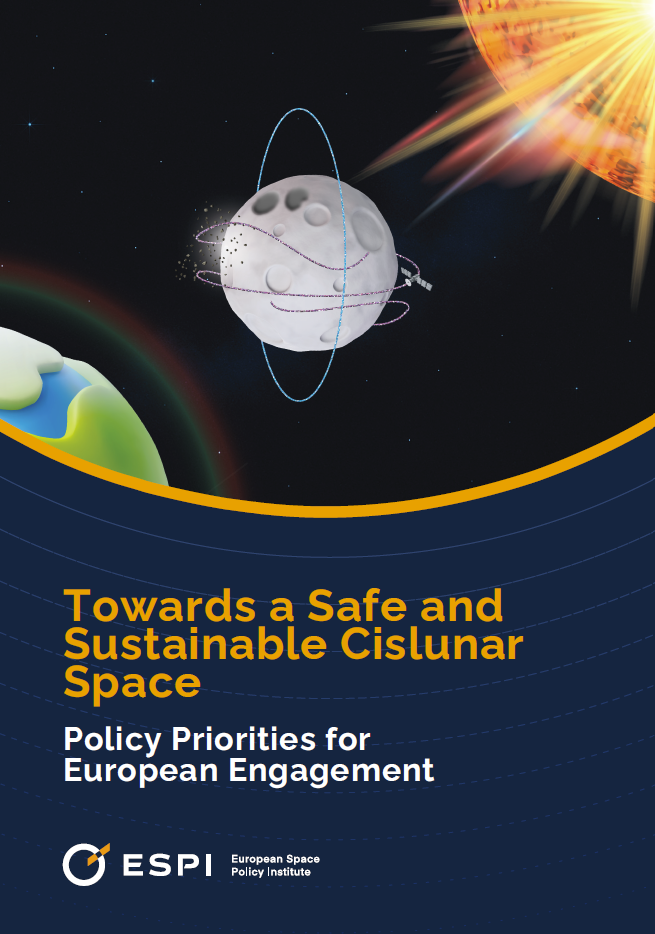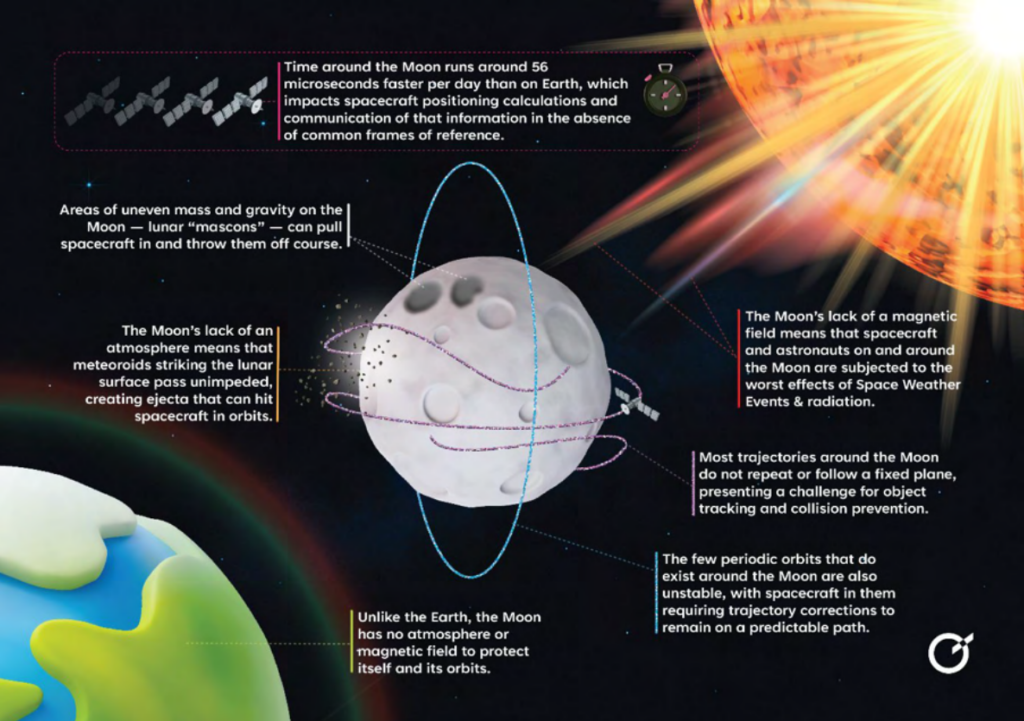As humanity sets its sights on the Moon once again, the space between Earth and the Moon—known as cislunar space—is becoming a strategic frontier of exploration. But with growing ambitions come growing risks.
Unlike past lunar missions, today’s plans go far beyond planting flags. Dozens of missions are being prepared, aiming to build permanent infrastructure, scientific outposts, and even a thriving lunar economy. However, the region lacks the most basic safety systems we take for granted on Earth or in low Earth orbit: traffic coordination, reliable communication, and protection from solar storms.
To address these issues, the European Space Policy Institute (ESPI) with support and technical input from ESA through the Protect Accelerator, has released a new study: “Towards a Safe and Sustainable Cislunar Space: Policy Priorities for European Engagement.” This timely report identifies the critical safety challenges emerging in this unique environment—and lays out why Europe must act now.

What is cislunar space, and why does it matter?
Cislunar space refers to the vast region between Earth and the Moon, including the orbits around the Moon itself. As more spacecraft enter this domain—both crewed and robotic—the chances of accidents, interference, or even conflict increase. But unlike Earth’s orbit, which is closely monitored and regulated, the Moon’s surroundings are still largely unmanaged.
The main challenges: Tracking, Debris, and Space Weather
The ESPI report highlights three major issues that urgently need to be addressed:
Space Situational Awareness (SSA) and Space Traffic Management (STM)
There is currently no dedicated system to monitor and coordinate objects near the Moon. As more missions use similar orbits—particularly the narrow “stable” areas in the vicinity of Lagrange points L4 and L5—risks of collision and miscommunication grow. Unlike Earth’s orbit, where satellites follow predictable paths, cislunar orbits are chaotic and harder to track. Without better tracking tools and communication standards, serious mishaps are likely.
Space Debris and End-of-Life procedures
Just like Earth orbit, the Moon’s neighbourhood is starting to accumulate space debris—from old rockets, mission failures, or uncontrolled crashes. Each object poses a risk to future missions. Worse, there are no shared rules for what to do with spacecraft at the end of their lives. If we don’t act now, the same debris problem we face near Earth could take root around the Moon.
Space Weather risks
The Moon lacks the magnetic shield and atmosphere that protects Earth from solar storms. This makes spacecraft and astronauts in cislunar space more vulnerable to radiation. In 2025, for example, India’s Chandrayaan-1 lost key sensors due to space weather effects. Today, forecasting is still rudimentary—often giving less than an hour’s warning for solar events. Improving this capability is vital for astronaut and missions’ safety.

Who’s doing what—and where Europe stands
Globally, countries are waking up to these challenges. The United States is developing cislunar tracking satellites and dedicated lunar traffic rules. Japan and South Korea are investing in cislunar observation missions and have included safety in national strategies. China is rapidly increasing its lunar presence and research.
In Europe, ESA has launched promising initiatives through its Space Safety Programme. For example, the Agency has developed pre-operational capabilities for interplanetary space weather services. Additionally, the proposed LEMO-TD demonstration mission, put forward at the 2025 Ministerial Council, aims to locate, detect, and track artificial objects and debris in cislunar orbits.
National agencies are contributing scientific payloads and research on debris and radiation. However, the report finds that overall, Europe’s engagement remains fragmented and reactive—lagging behind in both investment and strategic coordination.
Why Europe must step up: Five key reasons
The ESPI report presents a compelling case for why Europe should lead on cislunar safety. Here are five reasons why this matters:
1. To protect Europe’s own missions
Without better safety infrastructure, Europe’s future lunar missions—both institutional and commercial—face higher risks of failure. Whether it’s the upcoming Argonaut lander or participation in the Lunar Gateway, mission success increasingly depends on coordination, tracking, and radiation resilience.
2. To ensure strategic autonomy
If Europe does not develop its own monitoring and safety tools, it will depend on foreign systems to know what’s happening around the Moon. That’s a risky bet in such a strategic domain. Investing in independent capabilities such as SSA capabilities, collision avoidance protocols, interference mitigation strategies, and secure data transmission ensures that Europe can operate on its own terms.
3. To spur innovation and economic growth
Cislunar safety is not just a regulatory concern—it’s a business opportunity. European companies could become global leaders in lunar navigation, tracking software, or space-weather forecasting. Public investment today could enable a thriving commercial sector tomorrow.
4. To promote responsible and sustainable exploration
Europe has long championed sustainable space practices—like setting standards for debris mitigation in Earth orbit. By bringing this ethos to cislunar space, Europe can lead in defining what responsible lunar exploration looks like. That includes transparent operations, scientific preservation, and protecting the lunar environment for future generations.
5. To shape international norms and standards
Whoever builds the first systems and frameworks around the Moon will have the most influence in setting the “rules of the road.” If Europe wants to be at the table when global decisions are made—at the United Nations (UN) or in others multilateral forums—it must lead by example and act early.
From report to action: A window of opportunity
The upcoming ESA Ministerial Council in 2025 offers a unique chance for Europe to place cislunar safety at the heart of its exploration strategy. The ESPI report encourages clear policy commitments: support for space-based SSA, shared standards for end-of-life disposal, and accelerated research into space weather forecasting.
This isn’t just a call for agencies—it’s an invitation to Europe’s entire space community: governments, companies, researchers, and citizens. Building a safe and sustainable cislunar space will require international collaboration and European leadership.
Conclusion: Shaping the future, together
Cislunar space is no longer the domain of science fiction. It is becoming a strategic and operational reality—one where the choices made today will shape the next decades of space exploration.
Europe has the expertise, the values, and the momentum to lead. But leadership requires action.
By investing in safety, Europe can help ensure that humanity’s return to the Moon is not only ambitious—but also responsible, sustainable, and inclusive. The ESPI report shows the path forward. Now is the time to follow it.

Discussion: no comments